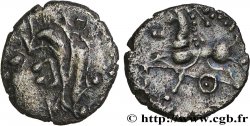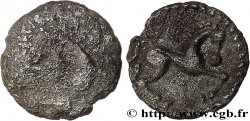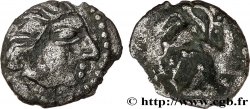bga_265502 - GALLIA - LEMOVICES (Area of Limoges) Statère à la grue
недоступный.
Товар уже продан в нашем интернет-магазине (2013)
Цена: : 1 800.00 €
Товар уже продан в нашем интернет-магазине (2013)
Цена: : 1 800.00 €
Тип Statère à la grue
Дата: c. 100-50 BC.
Монетный двор / Город: Limoges (87)
Металл: electrum
Диаметр: 17,5 mm
Ориентация осей монеты: 5 h.
Вес: 4,16 g.
Редкость: R3
Комментарии о состоянии
Exemplaire avec un revers exceptionnel. Le flan est un peu court mais régulier. Frappe centrée des deux côtés, mais un peu molle sur l’ensemble de l’avers. Patine sombre et brillante, difficile à rendre en photographie
Ссылки в каталоге: :
Происхождение:
Ce statère provient de la vente VINCHON du 25 mai 1998. Il est repris comme monnaie type dans le MONETA III sous les n° 43 et 44 (sic). C’est le n° 103 de MONNAIES 50
Лицевая сторона
Аверс: легенда: ANÉPIGRAPHE.
Аверс: описание: Tête à droite, la chevelure en grosses mèches aquitaniques, l’oreille marquée.
Обратная сторона
Реверс: легенда: ANÉPIGRAPHE.
Реверс: Описание: Cheval à droite, une grue posée sur la croupe entre deux annelets pointés ; un trèfle entre les jambes.
Комментарий
Cette variété correspond à la classe II de la série 1076 “à la grue et au trèfle” du Nouvel Atlas. Ce statère, de bas aloi et de poids léger, est probablement parmi les plus belles représentations de revers pour cette série.
L’oiseau posé sur la croupe du cheval est particulièrement complet sur cet exemplaire, comme tout le reste du type, si ce n’est le trèfle partiellement hors flan.
Le motif d‘accolade partant de la bouche (hors flan sur cet exemplaire) devant le visage, est parfois interprété comme le signe de la parole ; on retrouve ce détail sur les statères des Bituriges, mais aussi sous forme des deux dauphins, plus ou moins stylisés, sur la plupart des monnaies d’argent du sud, dites “à la croix”.
On notera qu’au revers, le cheval a lui aussi une sorte de volute qui lui sort de la bouche !.
This variety corresponds to class II of series 1076 “with crane and clover” of the New Atlas. This stater, of low alloy and light weight, is probably among the most beautiful reverse representations for this series. The bird perched on the horse’s rump is particularly complete on this example, like all the rest of the type, except for the clover partially off-flan. The brace motif starting from the mouth (off-flan on this example) in front of the face, is sometimes interpreted as the sign of speech; we find this detail on the staters of the Bituriges, but also in the form of the two dolphins, more or less stylized, on most of the southern silver coins, called “with the cross”. It should be noted that on the reverse, the horse also has a sort of volute coming out of its mouth!
L’oiseau posé sur la croupe du cheval est particulièrement complet sur cet exemplaire, comme tout le reste du type, si ce n’est le trèfle partiellement hors flan.
Le motif d‘accolade partant de la bouche (hors flan sur cet exemplaire) devant le visage, est parfois interprété comme le signe de la parole ; on retrouve ce détail sur les statères des Bituriges, mais aussi sous forme des deux dauphins, plus ou moins stylisés, sur la plupart des monnaies d’argent du sud, dites “à la croix”.
On notera qu’au revers, le cheval a lui aussi une sorte de volute qui lui sort de la bouche !.
This variety corresponds to class II of series 1076 “with crane and clover” of the New Atlas. This stater, of low alloy and light weight, is probably among the most beautiful reverse representations for this series. The bird perched on the horse’s rump is particularly complete on this example, like all the rest of the type, except for the clover partially off-flan. The brace motif starting from the mouth (off-flan on this example) in front of the face, is sometimes interpreted as the sign of speech; we find this detail on the staters of the Bituriges, but also in the form of the two dolphins, more or less stylized, on most of the southern silver coins, called “with the cross”. It should be noted that on the reverse, the horse also has a sort of volute coming out of its mouth!








 Cообщить об ошибке
Cообщить об ошибке Распечатать страницу
Распечатать страницу Отправить мой выбор
Отправить мой выбор Задать вопрос
Задать вопрос Consign / sell
Consign / sell
 Информация
Информация









